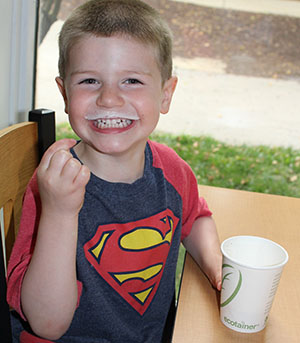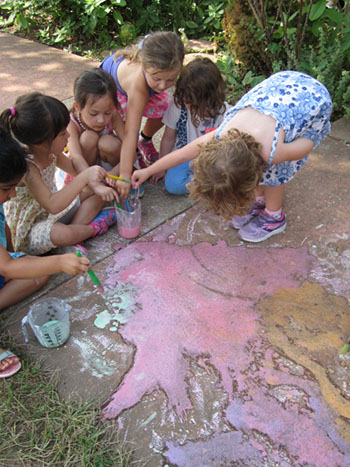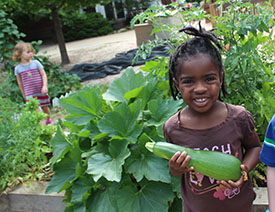Week 3
What is a Gas?
This week another book about matter by Jennifer Boothroyd, was read , and this time it focused on "gas". Children learned it can fill up space like when you breath in air into your lungs or when a balloon is blown up. Ms. Damron poured baking soda into a balloon and fit it over the neck of a bottle filled with vinegar. When the balloon was lifted so the baking soda dropped into the vinegar bubbles appeared and much to the amazement of the children the balloon expanded as if someone had blown it up. They learned this gas was carbon dioxide. In addition a dehumidifier was plugged in to show the children steam. Many children had a dehumidifier at home and shared that information with the class.

Ellicott Dining Hall
Close to the CYC are two diners. The class was invited to one of those called Ellicott Diner to observe some of the mixing going on. Greg Thompson , a long time friend of the CYC, set up three milkshake stations for the campers. The base of the milkshakes was vanilla ice cream made at the University. The children were able to choose from many "mix-ins" including jimmys, m & m's, and oreos. The mixtures were put into stainless steel cups and attached to a milk shake mixing machine to combine the ingredients. This was a very popular activity needless to say.
Before going to the Diner the children made predictions about what they might see. They related the activity to restaurants they had been to before and most predictions were right. One boy thought there might be lots of paper work and when asked, Mr. Thompson said yes there was because he had to order things and pay bills.
Teacher's and children were not sure what to expect on day two at Ellicott Dining Hall but were pleasantly surprised to do the same thing all over again! This time everything went even more smoothly since adults and children knew what to expect. It looked like the chocolate toppings were the favorite. Several children recognized that the solid ice cream mixed with the liquid milk became a liquid after the mixer whirred it up.

Using a Mixer
Taking a survey, campers found out that all of the children had kitchen mixers in their house. Some did not remember but were assured by their parents that they did. On this day the class made banana muffins and used a kitchen mixer belonging to one of the teachers. Many children had a chance to operate the mixer to mix the banana muffin batter. Two batches were made, one with baking soda and baking powder, and one without either. It was discovered that the soda and powder made the muffins "bigger", or made them rise. The color was slightly different as well. All of the muffins were consumed so it must not affected the taste much.
Corn Starch

Three mixtures using corn starch were made this week. There are a lot of science related recipes on the Internet that use this ingredient. The first mixture was to combine 1/2 cup of corn starch with 1/2 cup of water and some color to make sidewalk paint. The color used was a mixture the children had made earlier in the week using ovals from a water color paint set and diluting it into a small cups of water. This proved not to be strong enough, so regular food coloring was used to make the four colors of paint darker. This mixture worked very well.
The second corn starch mixture was 1/2 cup of cornstarch to 1 cup of water to make finger paint. The mixture had to be heated to thicken and food color was added to make the three primary colors. This mixture turned out to be a gloppy mess and did not work like finger paint at all. Some children enjoyed the sensory feel of playing with it though.
The third corn starch mixture made was oobleck, gloop, or slime. This mixture is made by adding 1/2 cup of corn starch to a cup of water. Green color was chosen for it's icky effect and the campers dove their hands into the mixture kneading and playing with it. Oobleck has interesting properties and when it is still it runs like a liquid and when it is pushed on it feels like a solid.

